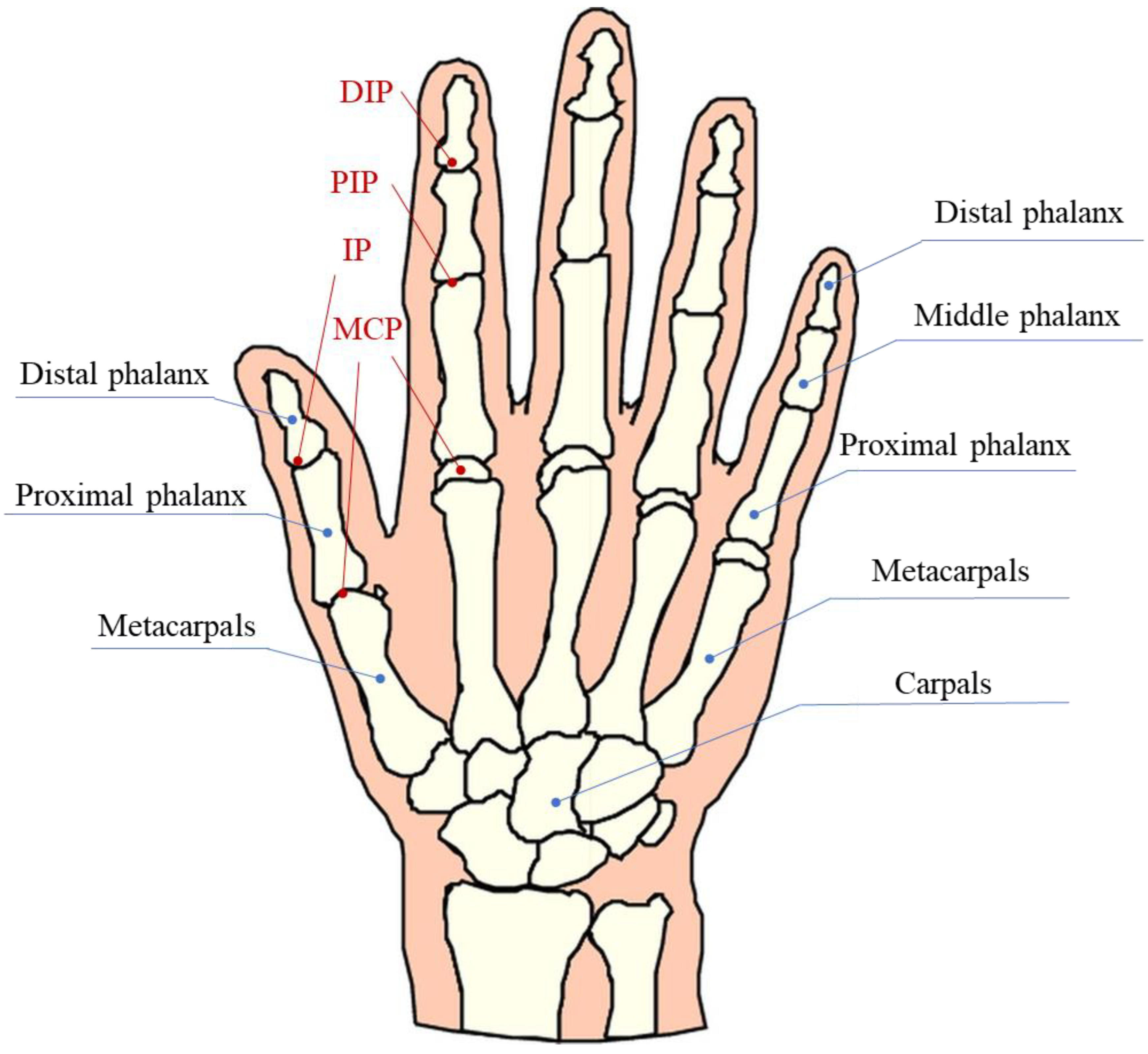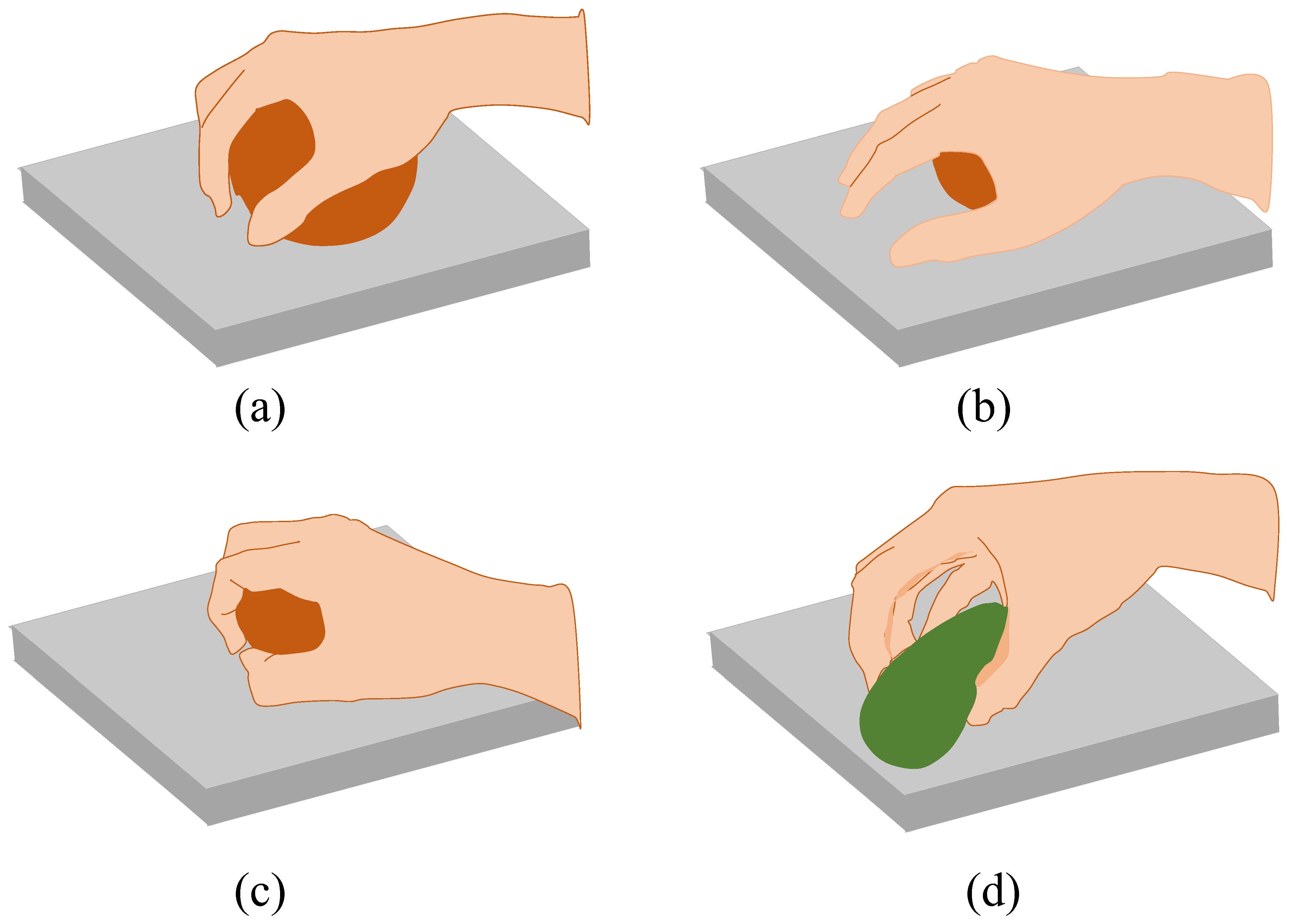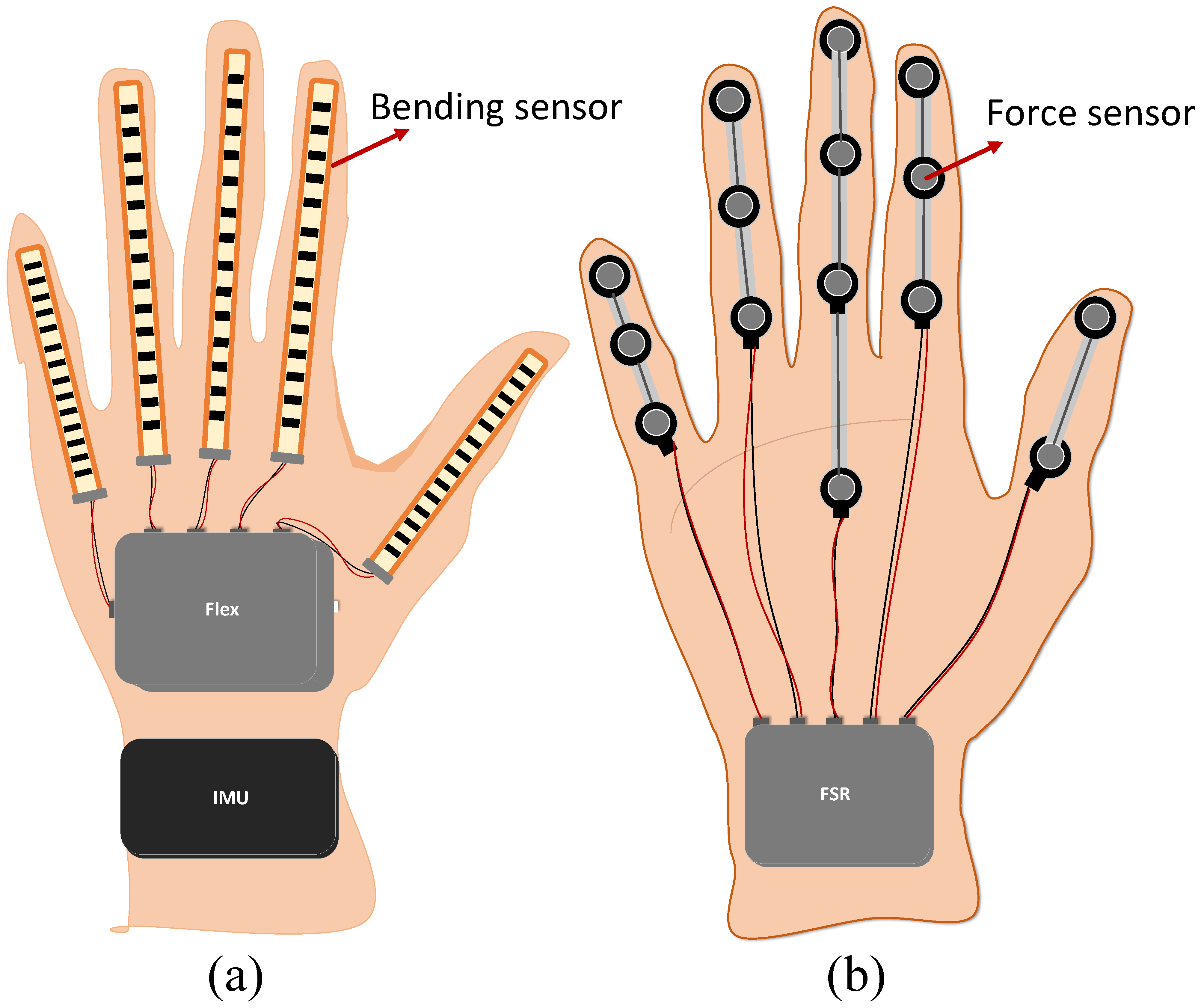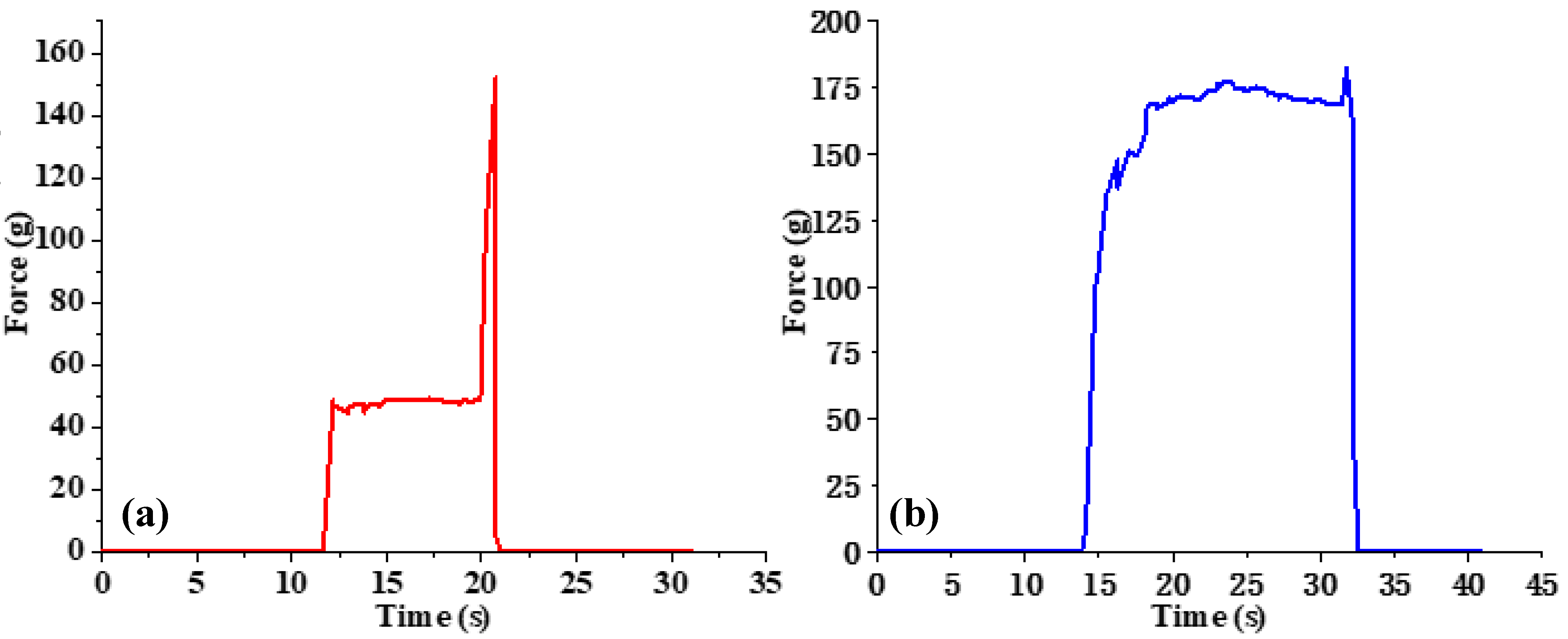Human Grasp Mechanism Understanding, Human-Inspired Grasp Control and Robotic Grasping Planning for Agricultural Robots
Abstract
:1. Introduction
2. Materials and Methods
2.1. Physiological Structure of the Human Hand
2.2. Grab Force Closure and Stability
2.3. Grasping Posture Analysis
2.4. Tactile Glove and Multi-Sensor System
2.4.1. Tactile Glove Design
2.4.2. Bending Sensing System
2.4.3. Force Sensing System
2.4.4. IMU Interactive Perception System
3. Results and Discussion
3.1. Finger Correlation and Cooperation Analysis
3.1.1. Curvature Correlation
3.1.2. Force Correlation
3.2. Slippage Detection
3.3. External Interaction Judgment
3.4. Grasping Control and Planning for Manipulator
4. Conclusions
Author Contributions
Funding
Conflicts of Interest
References
- Han, C.; Hu, X.; Zhang, J.; You, J.; Li, H. Design and testing of the mechanical picking function of a high-speed seedling auto-transplanter. Artif. Intell. Agric. 2021, 5, 64–71. [Google Scholar] [CrossRef]
- Ozawa, R.; Tahara, K. Grasp and dexterous manipulation of multi-fingered robotic hands: A review from a control view point. Adv. Robot. 2017, 31, 1030–1050. [Google Scholar] [CrossRef]
- Paradkar, V.; Raheman, H.; Rahul, K. Development of a metering mechanism with serial robotic arm for handling paper pot seedlings in a vegetable transplanter. Artif. Intell. Agric. 2021, 5, 52–63. [Google Scholar] [CrossRef]
- Wang, Y.; Gupta, U.; Parulekar, N.; Zhu, J. A soft gripper of fast speed and low energy consumption. Sci. China Technol. Sci. 2019, 62, 31–38. [Google Scholar] [CrossRef]
- Zhang, B.; Xie, Y.; Zhou, J.; Wang, K.; Zhang, Z. State-of-the-art robotic grippers, grasping and control strategies, as well as their applications in agricultural robots: A review. Comput. Electron. Agric. 2020, 177, 105694. [Google Scholar] [CrossRef]
- Sparrow, R.; Howard, M. Robots in agriculture: Prospects, impacts, ethics, and policy. Precis. Agric. 2021, 22, 818–833. [Google Scholar] [CrossRef]
- Feng, Q. End-Effector Technologies. In Fundamentals of Agricultural and Field Robotics; Springer: Cham, Switzerland, 2021; pp. 191–212. [Google Scholar]
- Zhang, B.; Zhou, J.; Meng, Y.; Zhang, N.; Gu, B.; Yan, Z.; Idris, S.I. Comparative study of mechanical damage caused by a two-finger tomato gripper with different robotic grasping patterns for harvesting robots. Biosyst. Eng. 2018, 171, 245–257. [Google Scholar] [CrossRef]
- Wang, N.; Ge, X.; Guo, H.; Cui, C.; Zhang, X. A kind of soft pneumatic actuator based on multi-material 3D print technology. In Proceedings of the 2017 IEEE International Conference on Robotics and Biomimetics (ROBIO), Macau, Macao, 5–8 December 2017; pp. 823–827. [Google Scholar]
- Lehnert, C.; English, A.; McCool, C.; Tow, A.W.; Perez, T. Autonomous sweet pepper harvesting for protected cropping systems. IEEE Robot. Autom. Lett. 2017, 2, 872–879. [Google Scholar] [CrossRef] [Green Version]
- Li, Z.; Miao, F.; Yang, Z.; Chai, P.; Yang, S. Factors affecting human hand grasp type in tomato fruit-picking: A statistical investigation for ergonomic development of harvesting robot. Comput. Electron. Agric. 2019, 157, 90–97. [Google Scholar] [CrossRef]
- Zhang, Z.; Zhou, J.; Yan, Z.; Wang, K.; Mao, J.; Jiang, Z. Hardness recognition of fruits and vegetables based on tactile array information of manipulator. Comput. Electron. Agric. 2021, 181, 105959. [Google Scholar] [CrossRef]
- Xie, Y.; Zhang, B.; Zhou, J.; Bai, Y.; Zhang, M. An integrated multi-sensor network for adaptive grasping of fragile fruits: Design and feasibility tests. Sensors 2020, 20, 4973. [Google Scholar] [CrossRef] [PubMed]
- Schlesinger, G. Der mechanische aufbau der künstlichen glieder. In Ersatzglieder und Arbeitshilfen; Springer: Berlin/Heidelberg, Germany, 1919; pp. 321–661. [Google Scholar]
- Napier, J.R. The prehensile movements of the human hand. J. Bone Jt. Surgery. Br. 1956, 38, 902–913. [Google Scholar] [CrossRef] [PubMed] [Green Version]
- Iberall, T. Opposition space as a structuring concept for the analysis of skilled hand movements. Gener. Modul. Action Patterns 1986, 15, 158–173. [Google Scholar]
- Fischer, G. A critic for LISP. In Proceedings of the 10th International Joint Conference of Artificial Intelligence, Milan, Italy, 23–28 August 1987. [Google Scholar]
- Vergara, M.; Sancho-Bru, J.L.; Gracia-Ibáñez, V.; Pérez-González, A. An introductory study of common grasps used by adults during performance of activities of daily living. J. Hand Ther. 2014, 27, 225–234. [Google Scholar] [CrossRef] [PubMed] [Green Version]
- Feix, T.; Romero, J.; Schmiedmayer, H.-B.; Dollar, A.M.; Kragic, D. The grasp taxonomy of human grasp types. IEEE Trans. Hum. -Mach. Syst. 2015, 46, 66–77. [Google Scholar] [CrossRef]
- Zheng, W.; Xie, Y.; Zhang, B.; Zhou, J.; Zhang, J. Dexterous robotic grasping of delicate fruits aided with a multi-sensory e-glove and manual grasping analysis for damage-free manipulation. Comput. Electron. Agric. 2021, 190, 106472. [Google Scholar] [CrossRef]
- Billard, A.; Kragic, D. Trends and challenges in robot manipulation. Science 2019, 364, eaat8414. [Google Scholar] [CrossRef]
- Starke, J.; Chatzilygeroudis, K.; Billard, A.; Asfour, T. On force synergies in human grasping behavior. In Proceedings of the 2019 IEEE-RAS 19th International Conference on Humanoid Robots (Humanoids), Toronto, ON, Canada, 15–17 October 2019; pp. 72–78. [Google Scholar]
- Naceri, A.; Moscatelli, A.; Haschke, R.; Ritter, H.; Santello, M.; Ernst, M.O. Multidigit force control during unconstrained grasping in response to object perturbations. J. Neurophysiol. 2017, 117, 2025–2036. [Google Scholar] [CrossRef]
- Chen, X.; Li, Z.; Wang, Y.; Liu, J. Effect of fruit and hand characteristics on thumb–index finger power-grasp stability during manual fruit sorting. Comput. Electron. Agric. 2019, 157, 479–487. [Google Scholar] [CrossRef]
- Nicholas, J.W.; Corvese, R.J.; Woolley, C.; Armstrong, T.J. Quantification of hand grasp force using a pressure mapping system. Work 2012, 41 (Suppl. S1), 605–612. [Google Scholar] [CrossRef] [Green Version]
- Li, G.; Liu, S.; Wang, L.; Zhu, R. Skin-inspired quadruple tactile sensors integrated on a robot hand enable object recognition. Sci. Robot. 2020, 5, eabc8134. [Google Scholar] [CrossRef] [PubMed]
- Battaglia, E.; Bianchi, M.; Altobelli, A.; Grioli, G.; Catalano, M.G.; Serio, A.; Santello, M.; Bicchi, A. Thimblesense: A fingertip-wearable tactile sensor for grasp analysis. IEEE Trans. Haptics 2015, 9, 121–133. [Google Scholar] [CrossRef] [PubMed]
- Sundaram, S.; Kellnhofer, P.; Li, Y.; Zhu, J.-Y.; Torralba, A.; Matusik, W. Learning the signatures of the human grasp using a scalable tactile glove. Nature 2019, 569, 698–702. [Google Scholar] [CrossRef] [PubMed]
- Shin, H.; Hwang, H.; Yoon, H.; Lee, S. Integration of deep learning-based object recognition and robot manipulator for grasping objects. In Proceedings of the 2019 16th International Conference on Ubiquitous Robots (UR), Jeju, Korea, 24–27 June 2019; pp. 174–178. [Google Scholar]
- Takahashi, T.; Tsuboi, T.; Kishida, T.; Kawanami, Y.; Shimizu, S.; Iribe, M.; Fukushima, T.; Fujita, M. Adaptive grasping by multi fingered hand with tactile sensor based on robust force and position control. In Proceedings of the 2008 IEEE International Conference on Robotics and Automation, Pasadena, CA, USA, 19–23 May 2008; pp. 264–271. [Google Scholar]
- Qin, J.; Liu, H.; Zhang, G.; Che, J.; Sun, F. Grasp stability prediction using tactile information. In Proceedings of the 2017 2nd International Conference on Advanced Robotics and Mechatronics (ICARM), Hefei and Tai’an, China, 27–31 August 2017; pp. 498–503. [Google Scholar]
- Wang, J.; Li, B.; Li, Z.; Zubrycki, I.; Granosik, G. Grasping behavior of the human hand during tomato picking. Comput. Electron. Agric. 2021, 180, 105901. [Google Scholar] [CrossRef]
- Controzzi, M.; Cipriani, C.; Jehenne, B.; Donati, M.; Carrozza, M.C. Bio-inspired mechanical design of a tendon-driven dexterous prosthetic hand. In Proceedings of the 2010 Annual International Conference of the IEEE Engineering in Medicine and Biology, Buenos Aires, Argentina, 31 August–4 September 2010; pp. 499–502. [Google Scholar]
- Aghili, F.; Su, C.-Y. Control of constrained robots subject to unilateral contacts and friction cone constraints. In Proceedings of the 2016 IEEE International Conference on Robotics and Automation (ICRA), Stockholm, Sweden, 16–21 May 2016; pp. 2347–2352. [Google Scholar]
- Bicchi, A.; Kumar, V. Robotic grasping and contact: A review. In Proceedings of the 2000 ICRA. Millennium Conference. IEEE International Conference on Robotics and Automation. Symposia proceedings (Cat. No. 00CH37065), San Francisco, CA, USA, 24–28 April 2000; pp. 348–353. [Google Scholar]
- León, B.; Morales, A.; Sancho-Bru, J. Robot grasping foundations. In From Robot to Human Grasping Aimulation; Springer: Berlin/Heidelberg, Germany, 2014; pp. 15–31. [Google Scholar]
- Tang, W.; Ji, W.; Meng, X.; Xu, B.; Zhao, D.; Ding, S. Research on Grasp Force Control of Apple-Picking Robot Based on Improved Impedance Control. In Proceedings of the Chinese Intelligent Systems Conference, Xiamen, China, 22–23 October 2016; pp. 133–142. [Google Scholar]
- Nguyen, V.-D. Constructing force-closure grasps. Int. J. Robot. Res. 1988, 7, 3–16. [Google Scholar] [CrossRef]
- Sadun, A.; Jalani, J.; Sukor, J. Force Sensing Resistor (FSR): A brief overview and the low-cost sensor for active compliance control. In Proceedings of the First International Workshop on Pattern Recognition, Tokyo, Japan, 11–13 May 2016; pp. 222–226. [Google Scholar]













| Shape | Size | Gesture | Finger | VF Allocation | |
|---|---|---|---|---|---|
| Sphere | Palm-aligned power grab | 5 | VF1: T VF2: I + M + R VF3: L | ||
| Proximal phalanx-aligned power grab | 5 | VF1: T VF2: I + M + R VF3: L | |||
| Precision grab | 2 | VF1: T VF2: I | |||
| cylinder | Palm-aligned power grab | 5 | VF1: T VF2: I + M + R VF3: L | ||
| Palm-aligned power grab | VF2: T VF2: I (M/R/L) | ||||
| Proximal phalanx-aligned power grab | 5 | VF1: T VF2: I + M + R VF3: L | |||
| Proximal phalanx-aligned power grab | VF2: T VF2: I (M/R/L) | ||||
| Precision grab | 5 | VF1: T VF2: I + M + R VF3: L | |||
| Precision grab | VF2: T VF2: I (M/R/L) | ||||
| cone | Palm-aligned power grab | 5 | VF1: T VF2: I + M + R VF3: L | ||
| Precision grab | VF2: T VF2: I (M/R/L) | ||||
| Diameter (cm) | Thumb (°) | Index Finger (°) | Middle Finger (°) | Ring Finger (°) | Little Finger (°) |
|---|---|---|---|---|---|
| 5.8 | 67.0804 | 84.6916 | 84.84 | 90.6295 | 110.0556 |
| 6 | 63.385 | 85.3011 | 89.8706 | 98.9282 | 104.8757 |
| 6.5 | 62.5786 | 83.1954 | 85.3294 | 87.2685 | 68.1654 |
| 6.8 | 62.4524 | 81.5481 | 81.1659 | 84.06 | 66.1351 |
| 7.0 | 50.1655 | 75.2654 | 78.6145 | 45.2645 | 60.1874 |
| 7.4 | 38.8601 | 71.8594 | 74.6515 | 70.3559 | 50.0897 |
| 7.5 | 39.1324 | 71.8624 | 70.1338 | 70.6458 | 54.2648 |
| 7.7 | 39.7285 | 71.8795 | 67.8881 | 70.2586 | 58.893 |
| 8.4 | 34.1429 | 55.5814 | 53.9732 | 46.116 | 32.4522 |
| 9.1 | 36.5123 | 65.8141 | 65.0091 | 69.5407 | 45.0819 |
| 9.5 | 14.7934 | 75.9312 | 70.5472 | 73.6385 | 41.8194 |
| Finger | MCP-PIP | MCP-DIP | PIP-DIP |
|---|---|---|---|
| Thumb | 0.756522(IP) | \ | \ |
| Index finger | 0.399683 | 0.369631 | 0.593295 |
| Middle finger | 0.531877 | 0.192749 | 0.651953 |
| Ring finger | 0.271122 | 0.432492 | 0.837198 |
| Little finger | 0.795578 | 0.607841 | 0.670623 |
Publisher’s Note: MDPI stays neutral with regard to jurisdictional claims in published maps and institutional affiliations. |
© 2022 by the authors. Licensee MDPI, Basel, Switzerland. This article is an open access article distributed under the terms and conditions of the Creative Commons Attribution (CC BY) license (https://creativecommons.org/licenses/by/4.0/).
Share and Cite
Zheng, W.; Guo, N.; Zhang, B.; Zhou, J.; Tian, G.; Xiong, Y. Human Grasp Mechanism Understanding, Human-Inspired Grasp Control and Robotic Grasping Planning for Agricultural Robots. Sensors 2022, 22, 5240. https://doi.org/10.3390/s22145240
Zheng W, Guo N, Zhang B, Zhou J, Tian G, Xiong Y. Human Grasp Mechanism Understanding, Human-Inspired Grasp Control and Robotic Grasping Planning for Agricultural Robots. Sensors. 2022; 22(14):5240. https://doi.org/10.3390/s22145240
Chicago/Turabian StyleZheng, Wei, Ning Guo, Baohua Zhang, Jun Zhou, Guangzhao Tian, and Yingjun Xiong. 2022. "Human Grasp Mechanism Understanding, Human-Inspired Grasp Control and Robotic Grasping Planning for Agricultural Robots" Sensors 22, no. 14: 5240. https://doi.org/10.3390/s22145240
APA StyleZheng, W., Guo, N., Zhang, B., Zhou, J., Tian, G., & Xiong, Y. (2022). Human Grasp Mechanism Understanding, Human-Inspired Grasp Control and Robotic Grasping Planning for Agricultural Robots. Sensors, 22(14), 5240. https://doi.org/10.3390/s22145240









